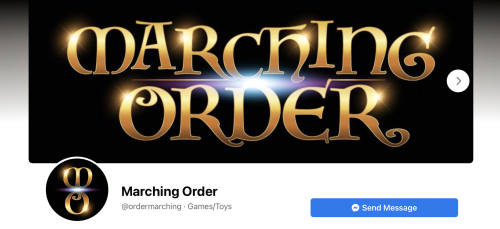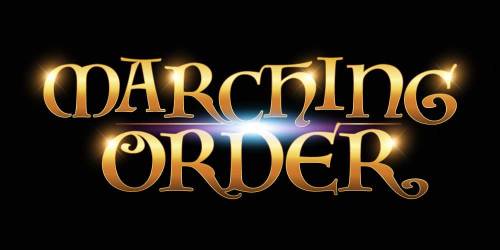#rpg design
It’s called Burning Frontier and it’s a work in progress.
You can take a look at what I have so far here.
Please let me know what you think!
Logo and Letter-Mark designed for Marching Order, a pre-recorded live-play tabletop RPG show.
https://www.facebook.com/Marching-Order-105171884987251
Post link
Player agency is paramount in good game design. And there’s no simpler way to take away all player agency than “Lose a turn” mechanics. A lot of Age of Exploration was inspired by Hero Quest, and it’s interesting that this simple ‘lose a turn’ spell appeared for both a player and for Zargon (The game master)

It’s an interesting piece of symmetry, considering HQ doesn’t have a lot…(D&D of course is entirely symmetrical) I decided right away that I didn’t want monsters to have any effects that “stunned” the players, because there’s few things less fun that doing nothing on your turn. (On the other side of the spectrum- I don’t create any spells for players that slow monsters or create zones of control, because it feels really weak when you slow a monster and it gets to you anyway)
IDID make 1 player spell that stuns enemies, and it turned out so powerful that we had to give it one of the lowest ranges, and the least damage of any spell.

But then I wanted to design Basalisks, and we decided right away that they’d be ambush predators who use chameleon-like illusionary camoflogue to blend into their surroundings, and we wanted to keep the ‘turns targets to stone’ theme intact, but we already knew we didn’t want it to be ‘lose a turn’
So my fix was to make the petrification effect creep up from a player’s feet, instead of instantaneous.
Here’s a breakdown
Turn 1- Feet stiffen: half speed, disadvantage to balance
Turn 2- Legs locked: Can’t move
Turn 3- Arms frozen/petrified: Can’t make weapon attacks but can still cast a cantrip
Turn 4- Fully petrified
Turn 5- Effect wears off in reverse (same as turn 3, etc.)
This gave players a very long lead up offered them a chance to react, reposition, and provides them 2 turns to drink a potion or cast purify, and 3 turns to cast dispel. (The light element cantrip, which I haven’t made a card for yet)
It also gives Basalisks a chance to escape a dangerous party of humans/humanoids

My current vidya-related fascination is Western RPGs from that weird liminal space of design from between 2001-2004, where the genre was just starting to leave PCs behind but hadn’t quitestarted being designed with consoles in mind first.
What I mean by that is that RPGs of any kind almost invariably have commands, UI, and perspective that’s meant to accommodate the particular type of control you’re using. Games are almost always designed so that how you physicallyinteract with the hardwareis reflective in how you interact with the software.
One of the reasons Real-Time Strategy games are so incredibly rare on consoles is that virtually all of them from 1993 onward drew direct lineage from Dune II, whose then-novel mouse controls took direct inspiration from the click-and-drag interface used by the Apple Macintosh. While some RTS games did exist prior to widespread adoption of mouse controls, Dune II had such a foundational influence on how games of its kind played that mouse and keyboard is practically in the very geneticsof Real-Time Strategy. Any attempt to separate mouse controls from the long-since-codified design of RTS games is going to end up feeling awkward and clunky, as Halo Wars learned the hard way.
So that brings us back to Western RPGs. Prior to around 2000, any RPG that wasn’t by a Japanese developer was assumed to be made for PCs first, and that came with all the design conventions appropriate for a mouse and keyboard. But back in the early aughts, there was beginning to be something of a shift. Throughout the late 90s the genre of RPG had been firmly defined by a “J.” So as the subsequent PS2 and Xbox era started up, we saw more PC-centric developers from the “W” side of RPGs begin to make the shift to consoles. Consoles were still largely new territory for these developers though, there were still some odd holdovers from PC game design in the games they put out.
Having recently started playing through both Knights of the Old Republic and Baldur’s Gate, what really struck me right out the gate is how these games play near identicallyfrom a purely mechanical standpoint. They’re both real-time-with-pause games that put a high degree of emphasis on party management, positioning, and timing your characters’ abilities through the use of queued commands. But KoToR also crucially changed the way you viewedyour characters’ actions, with the game now being seen through an over-the-shoulder camera that follows whichever character is currently selected.
This shift in camera made it mucheasier to follow the action from where the average console gamer saw it, which was on a CRT television placed some distance away from a couch. Without this simple change in how the game is viewed, it’s likely KoToR would have never even been a viable product on the Xbox.
At the same time though, Bioware’s assumptions of a mouse-controlled game still bleed into the menu designs, UI, and even some of the basic gameplay mechanics like moving to an object in the world by selecting it. Bethesda’s Morrowind was likewise made much more Xbox-friendly than their previous RPGs, mostly by way of the greatly reduced number of buttons needed for play, yet it also retained a lot of clearly PC-centric design elements in the status and dialogue menus. The end result was this very brief point in time where RPGs were in an awkward growing phase, between the designed-for-PC RPGs like Baldur’s Gate and Fallout 1, and the designed-for-consoles RPGs like Mass Effect and Fallout 3.In the past several years there’s been a big push to revive the older, more PC-focused RPGs with titles like Pillars of Eternity, but that weird in-between period where RPGs were not quite made for consoles but also not quite made for PCs is something I genuinely don’t think we’ll ever see again.



